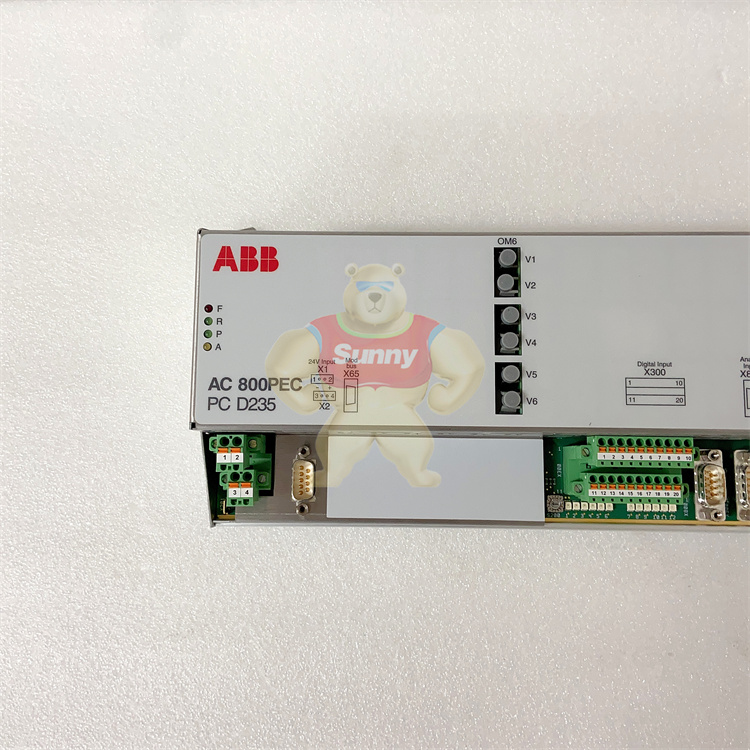As we all know, synchronous generators are excited by DC current. The basic principle of a generator is that a rotating magnetic field passes over the winding, creating an electromotive force in the winding, which generates electricity. The rotating magnetic field is generated by the excitation current through the rotor, so the excitation is very important for the generator, for the general generator, no excitation can not produce electricity, no matter the excitation is permanent magnet or electromagnetic. In traditional separately excited synchronous generators, the DC current is supplied by an attached DC exciter.
The principle of the generator and the origin of the excitation system

PCD235B1101 3BHE032025R1101
1. Working principle of generator
We all know that the working principle of the generator is to use wire cutting magnetic force lines to induce the electromagnetic induction principle of potential, the prime mover mechanical energy into electrical energy output. A synchronous generator consists of a stator and a rotor. The stator is the armature that generates electricity, and the rotor is the magnetic pole. The stator consists of armature core, uniformly discharged three-phase winding, frame and end cover. The rotor is usually of hidden pole type and consists of excitation winding, iron core and shaft, guard ring, center ring, etc.
The rotor’s excitation winding passes DC current to generate a nearly sinusoidal distribution of magnetic field (called the rotor field), and its effective excitation flux intersects the chain with the stationary armature winding. When the rotor rotates, the rotor magnetic field rotates together with it. After each rotation, the magnetic force line sequentially cuts each phase winding of the stator to induce the three-phase AC potential in the three-phase stator winding. When the generator is running with symmetrical load, the three – phase armature current combines to produce a rotating magnetic field with synchronous speed. The interaction between stator magnetic field and rotor magnetic field will produce braking torque. The mechanical torque input from the turbine does work against the braking torque.

PCD235B1101 3BHE032025R1101
Generators can produce both active and reactive power. Therefore, adjust the active power must adjust the intake of steam turbine. The strength of the rotor magnetic field directly affects the voltage of the stator winding, so the rotor current must be adjusted to adjust the generator terminal voltage or reactive power. The geometric sum of the active and reactive power of a generator is called the apparent power. The ratio of active power and apparent power is called the power factor (force rate) of the generator, and the rated power factor of the generator is generally 0.85. The system that supplies DC to generator rotor to establish rotor excitation is called generator excitation system.

PCD235B1101 3BHE032025R1101
2. Origin of generator excitation system
The power supply for the excitation current of the synchronous generator and its auxiliary equipment are collectively referred to as the excitation system. It is generally composed of two main parts: excitation power unit and excitation regulator. Excitation power unit provides excitation current to synchronous generator rotor; The excitation regulator controls the output of the excitation power unit according to the input signal and the given regulation criteria. The automatic excitation regulator of excitation system plays an important role in improving the stability of parallel units in power system. Especially, the development of modern power system leads to the tendency of reducing the stability limit of unit, and also promotes the continuous development of excitation technology.
Synchronous generator excitation system is mainly composed of power unit and regulator (device) two parts. As shown in the figure, the excitation power unit is the part of the excitation power supply that provides DC excitation current to the rotor winding of the synchronous generator, while the excitation regulator is the device that controls the output of the excitation power unit according to the input signal required by the control and the given regulation criteria. The whole system composed of excitation regulator, excitation power unit and generator itself is called excitation system control system.
Two, the role of generator excitation system

PCD235B1101 3BHE032025R1101
The main functions of the excitation system are:
1, maintain the generator terminal voltage at the given value, when the generator load changes, by adjusting the strength of the magnetic field to keep the terminal voltage.
2. Reasonable distribution of reactive power between parallel running units.
3. Improve the stability of power system, including static stability, transient stability and dynamic stability.
4. Improve the transient stability of generators running in parallel;
5, in the internal fault of the generator, magnetic out, in order to reduce the degree of failure loss;
6. Implement maximum and minimum excitation limits for generators according to operation requirements.

PCD235B1101 3BHE032025R1101
7. Adjust the excitation current according to the change of the generator load to maintain the terminal voltage as the given value;
8. Control reactive power distribution among generators in parallel operation;
9. Improve the static stability of generators running in parallel;
 1 Year Warranty
1 Year Warranty




